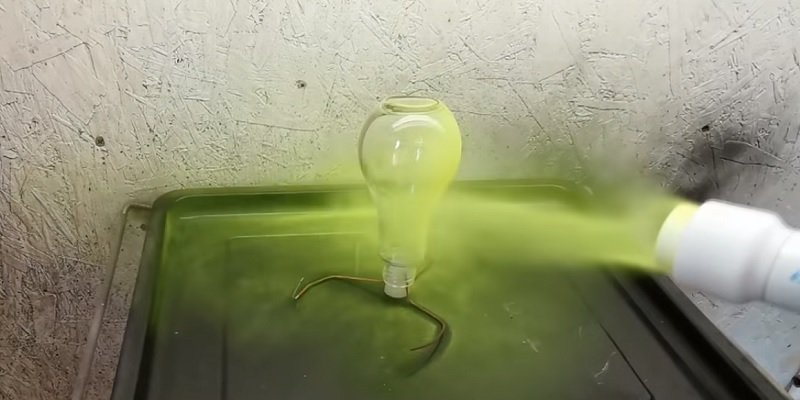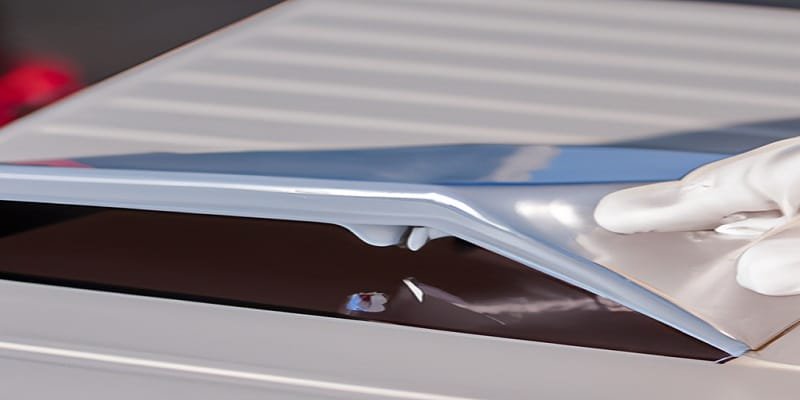In the world of home improvement and customization, powder coating has become a popular method for enhancing the appearance and durability of various surfaces. While it’s commonly associated with metals, a question that frequently arises is, “Can you powder coat glass?” This article will delve into the exciting world of powder coating and how it can be applied to glass surfaces.

Can You Powder Coat Glass?
Yes, you can powder coat glass! Powder coating is a versatile technique that can be used on various materials, including glass. This opens up a world of possibilities for customizing glass items, such as glassware, decorative glass, and more. Let’s explore how it works.
Read More: Can You Powder Coat Fiberglass?
Understand the Process of Powder Coating Glass for an Eye-Catching Finish
Powder coating glass is a transformative process where a dry powder is applied to the surface of the glass to create a durable, eye-catching finish. This process is often used in the manufacturing of decorative glassware and other glass pieces that require protection or an attractive finish. It is a popular finish for many applications, including automotive glass, mirrors, shower doors, and lighting.
The powder coating process begins with the selection of the powder coating material, typically a polyester or epoxy-based resin. The powder is then mixed with color pigments to create the desired color and texture. Once the powder is ready, it is applied to the glass surface with a spray gun.
As the powder is sprayed, an electrostatic charge is applied to the powder particles; this helps them adhere to the surface of the glass. The powder is then cured in an oven at high temperatures, typically around 400 degrees Fahrenheit, to create a durable finish.
Once cured, the powder coated glass can be finished with additional protective coatings or treatments, such as a clear topcoat to protect the finish from abrasion and UV light.
Additionally, decorative treatments can be applied to create unique finishes such as textures, patterns, and fades. The powder coating process is an excellent way to create a distinctive finish for glass.
It can be used to enhance the look of glass objects and protect them from wear and tear. With the right materials and techniques, the powder coating process can be used to achieve an eye-catching finish that will last for years.
Is Powder Coating a Durable Solution for Glass Surfaces?
Powder coating is a popular method for finishing glass surfaces due to its superior durability and cost efficiency. It is a widely used industrial process that involves the application of a finely ground pigment, or powder, to the surface of the glass. The powder is then bonded to the surface through the application of heat, forming a protective layer that is highly resistant to wear and tear.
Powder coating is considered to be one of the most durable finishing solutions for glass surfaces, as it is highly resistant to corrosion, cracking, scratches, and other common forms of damage. Additionally, it is also highly resistant to extreme temperatures, meaning it can be used in a variety of environments.
Furthermore, the application process is relatively simple and does not require extensive preparation, making it an economical solution for glass surfaces. However, powder coating is not suitable for use with surfaces that require intricate detail or fine lines.
Additionally, the use of powder coating on glass surfaces is not recommended for applications that require high visibility or transparency, as the powder can affect the clarity of the glass. Overall, powder coating is a durable and cost-effective solution for finishing glass surfaces in a variety of environments.
However, it is important to consider the particular requirements of the application before deciding whether powder coating is the best option.
Learn How to Prep Glass for Successful Powder Coating
When it comes to powder coating glass, the key to success lies in thorough and precise preparation. This process ensures that the powder adheres properly, resulting in a smooth, even, and durable finish. Here’s a step-by-step guide on how to prep glass for successful powder coating:
1. Cleaning and Degreasing
The first step in preparing glass for powder coating is to ensure it’s absolutely clean and free from any contaminants. Even tiny specks of dust or grease can interfere with the adhesion of the powder. Start by washing the glass with a mild detergent and warm water. Rinse thoroughly to remove all traces of soap.
Then, use a lint-free cloth or paper towels to wipe the glass dry. Pay extra attention to the edges and corners, as these are often overlooked spots where contaminants can lurk.
2. Abrasion
To improve the powder’s grip on the glass, you need to create a slightly rough surface. This can be achieved through abrasion. There are a couple of methods you can use, including sandblasting and sanding. Sandblasting, done by a professional, involves using compressed air to propel fine abrasive particles at the glass surface.
It provides an even, textured finish that promotes adhesion. On the other hand, sanding involves manually roughening the glass with sandpaper. Ensure you use a fine-grit sandpaper and work consistently across the entire surface.
3. Primer Application
Once you’ve thoroughly cleaned and abraded the glass, it’s time to apply a primer. This step is crucial for ensuring the powder coating adheres well and provides a consistent finish. There are special primers designed for glass, so be sure to use one of these. Apply a thin, even layer of primer to the glass using a spray gun or a brush. Follow the manufacturer’s instructions regarding drying time, which typically ranges from 30 minutes to a few hours.
4. Hot Flocking
After the primer has dried, it’s time for the hot flocking. hot flocking involves heating the glass to set the primer and ensure proper adhesion of the powder coating. The exact temperature and duration of hot flocking will vary depending on the primer and powder you’re using.
Typically, you’ll need to heat the glass to a temperature around 350-400 degrees Fahrenheit (175-200 degrees Celsius) for about 15-20 minutes.
5. Powder Coating
With the glass now primed and hot flocked, you’re ready to apply the powder coating. Be sure to choose a powder coating material designed for glass surfaces, as these are specially formulated to adhere well and provide a smooth finish.
The application process involves electrostatically charging the powder particles, causing them to stick to the glass. After coating, bake the glass again to melt and cure the powder coating, usually at the same temperature used for curing the primer.
By following these steps, you should be able to get a perfect powder coating finish on your glass surfaces. With the right preparation, your powder-coated glass will look great for years to come.
The Advantages of Powder Coating for a Uniquely Styled Glass Finish
Powder coating is a popular and increasingly versatile method for applying a temporary painted finish to glass surfaces. Unlike conventional paint applications, powder coating results in a unique two-tone finish that can be layered to create a range of effects.
This process is cost-effective and offers some key advantages compared to other painting techniques. Among its advantages, powder coating can provide superior corrosion protection, chemical resistance, toughness and impact resistance. This makes it ideal for outdoor elements such as glass balustrades, handrails and window frames, where superior durability is needed.
In fact, the two-tone finish can add a layer of protection that is unparalleled by traditional paints. The powder utilized in powder coating also yields highly vibrant colors that are far more vibrant than those available with conventional paints. As a result, glass surfaces can be coated in a wide range of colors, from classic whites and blacks to beiges and blues.
In addition, the powder also offers a wide range of texture and pattern options to customize the finished product. Perhaps one of the greatest advantages of powder coating for glass surfaces is the speed and ease of application. Powder coating is applied in a single pass, eliminating the need for multiple layers and sanding between each one.
This makes the process much faster than traditional painting techniques, providing a significant cost advantage. In addition to its advantages, powder coating is also an environmentally friendly and sustainable option. The powder coating process does not require any water or solvents, meaning no hazardous waste is created as a result.
Moreover, the powder used is also recyclable, making the process an eco-friendly option that is becoming increasingly popular with eco-minded consumers.
Overall, powder coating offers a highly efficient and sustainable alternative to traditional painting techniques. It can provide superior corrosion protection, chemical resistance, and superior colors and texture options to glass surfaces. With all of these advantages combined, powder coating is an ideal option for achieving a unique and attractive painted finish on glass.
Get Creative with Powder Coating – Transform Your Glass Surfaces
Creative Applications
Now that you know you can powder coat glass, let’s explore some creative applications:
- Custom Glassware: Personalize glassware, such as wine glasses, mugs, and vases, with unique colors and designs.
- Home Decor: Create stunning glass home decor items, like decorative panels and art pieces.
- Architectural Glass: Enhance the aesthetics of your space with powder-coated glass for doors, partitions, and more.
- Automotive Glass: Powder coat your vehicle’s glass for a sleek and distinctive look.
FAQs:
Will powder coat stick to glass?
Yes, powder coating can adhere to glass surfaces. However, it requires special preparation, like a high-temperature-resistant primer, to ensure proper adhesion.
Can powder-coated glass be used outdoors?
Yes, powder-coated glass is suitable for outdoor use. Its durability and resistance to the elements make it a great choice for outdoor applications.
How do I maintain powder-coated glass?
Maintaining powder-coated glass is easy. Simply clean it with a mild detergent and water. Avoid abrasive cleaners that could damage the coating.
Can I powder coat tempered glass?
Yes, tempered glass can be powder coated. However, it requires specific techniques to ensure the coating adheres properly.
Does powder coating affect the transparency of glass?
Powder coating can be applied with varying levels of opacity. You can choose a finish that suits your transparency preferences.
Is powder coating glass cost-effective?
While powder coating may have an initial cost, its durability and longevity make it a cost-effective choice in the long run.
Can I powder coat stained glass?
Yes, you can powder coat stained glass. It can add an extra layer of protection and enhance its appearance.
Can you powder coat glass windows?
Powder coating glass windows is not recommended. The extreme heat used in the process can cause the glass to shatter. Consider other alternatives for window finishes.
Can you powder coat glass tables?
Yes, glass tables can be powder coated. It’s essential to prepare the glass properly, and a professional should handle the process to ensure a smooth and durable finish.
Can you powder coat glass cups?
Powder coating glass cups is not advisable, as the process involves high temperatures that can damage or shatter the glass. It’s better to explore alternative methods for decorating glassware.
Conclusion
In the world of customization, powder coating offers an exciting way to transform glass surfaces. With its durability, versatility, and eco-friendliness, it’s a fantastic choice for enhancing the appearance of glassware, decor, and even architectural elements. So, when asking, “Can you powder coat glass?” the answer is a resounding yes! Embrace the possibilities of powder-coated glass and elevate your creative projects.


